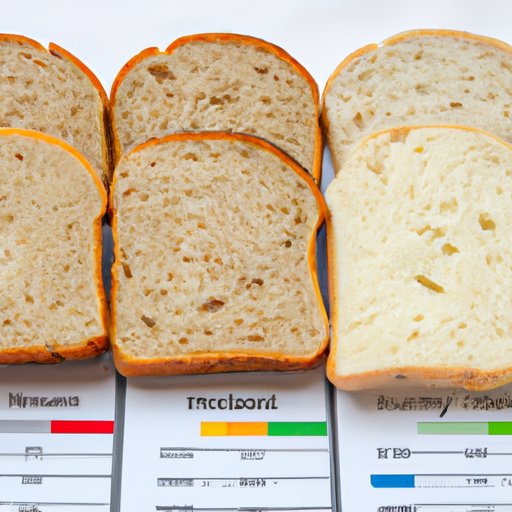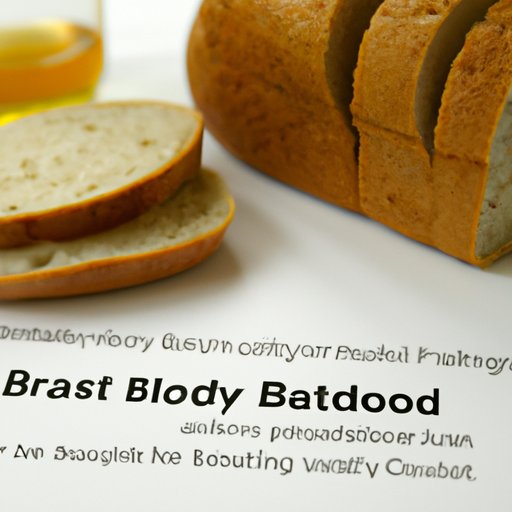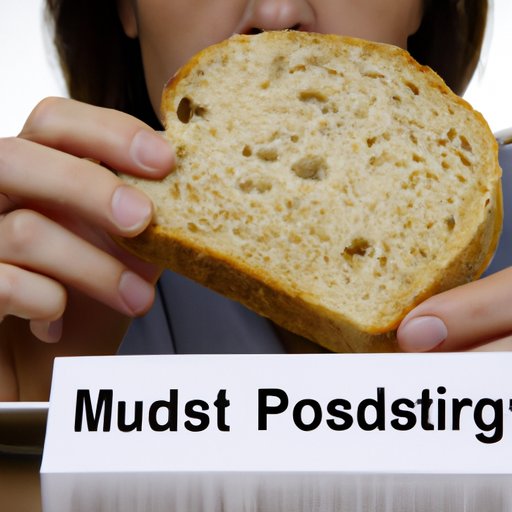Introduction
Bread is a staple food in many cultures around the world. It’s made from flour, water, yeast, and salt, and can be found in a variety of shapes, sizes, textures, and flavors. While some people avoid eating bread altogether, it can be a nutritious and delicious part of a balanced diet. In this article, we’ll explore which bread is healthy by comparing the nutritional profiles, health benefits, and potential risks associated with different types of bread.

Comparing Nutritional Profiles of Different Types of Bread
The nutritional profile of bread varies depending on the type of flour used and other ingredients added. Generally speaking, bread is a good source of carbohydrates, protein, and fiber. It also contains small amounts of fat, vitamins, and minerals. Here’s a breakdown of the nutrients found in one slice (28 grams) of white bread:
- Carbohydrates: 13 grams
- Protein: 2 grams
- Fat: 1 gram
- Fiber: 0.7 grams
- Vitamins: Thiamin, riboflavin, niacin, folate, pantothenic acid
- Minerals: Iron, magnesium, phosphorus, zinc, copper
Whole grain breads are a bit different. They contain more fiber, vitamins, and minerals than white bread. One slice (28 grams) of whole wheat bread provides:
- Carbohydrates: 15 grams
- Protein: 3 grams
- Fat: 1 gram
- Fiber: 2.4 grams
- Vitamins: Thiamin, riboflavin, niacin, folate, pantothenic acid
- Minerals: Iron, magnesium, phosphorus, zinc, copper

Analyzing Health Benefits of Whole Grain Breads
Whole grain breads are an excellent source of essential nutrients. The high fiber content helps promote regularity and may reduce the risk of certain diseases, such as heart disease, diabetes, and certain types of cancer. Studies have shown that people who eat whole grain breads are less likely to gain weight and more likely to maintain a healthy body weight over time.
“Eating whole grains like whole wheat bread is beneficial for health,” says registered dietitian Maryann Walsh. “They are rich in fiber, which helps reduce cholesterol and improve blood sugar control. They are also a great source of vitamins and minerals.”
Reviewing Quality of Ingredients in Different Breads
When choosing bread, it’s important to read the ingredient list carefully. Breads made from whole grains are the healthiest option, as they provide more fiber, vitamins, and minerals than refined grains. Additionally, look out for added sugars, which can add unnecessary calories and contribute to weight gain.
Examining Effects of Bread Consumption on Weight Management
Eating bread can have a positive or negative effect on weight management, depending on the type of bread consumed and the amount eaten. Bread is generally low in calories, making it a good choice for those watching their weight. However, if eaten in large quantities, it can contribute to weight gain.
Additionally, bread can be filling, helping to keep hunger at bay between meals. This can be helpful for those looking to lose weight, as it helps prevent overeating and snacking on unhealthy foods.
Exploring Impact of Bread on Blood Sugar Levels
The glycemic index (GI) is a measure of how quickly a food raises blood sugar levels. Foods with a high GI are absorbed quickly by the body, causing a rapid rise in blood sugar. On the other hand, foods with a low GI are absorbed slowly, leading to a gradual increase in blood sugar.
White bread has a high GI, while whole grain breads tend to have a lower GI. The glycemic load (GL) is another measure of how a food affects blood sugar levels. It takes into account both the GI and the amount of carbohydrate in a food. White bread has a higher GL than whole grain breads, meaning it can cause a more significant spike in blood sugar.

Investigating Potential Risks Associated with Eating Bread
Although bread can be a nutritious part of a balanced diet, it’s important to be aware of the potential risks associated with eating too much. Breads made with refined flours tend to be high in sodium, which can increase blood pressure and raise the risk of heart disease. Additionally, some breads contain allergens such as wheat, gluten, dairy, and nuts, so it’s important to check the label before consuming.
Evaluating Similarities and Differences Between White, Wheat, and Other Specialty Breads
White, wheat, and specialty breads all have their own unique flavor and texture. When it comes to nutrition, however, there are some similarities and differences to consider. White bread tends to be low in fiber and vitamins, while whole wheat bread is a better source of these nutrients. Specialty breads, such as rye and pumpernickel, are usually higher in fiber and other nutrients than white or wheat breads.
Conclusion
Bread can be a nutritious and delicious part of a balanced diet. Different types of bread have different nutritional profiles and health benefits, so it’s important to choose wisely. Whole grain breads are typically the healthiest option, as they provide more fiber, vitamins, and minerals than white breads. It’s also important to pay attention to the quality of ingredients and the effects of bread consumption on weight management and blood sugar levels.
(Note: Is this article not meeting your expectations? Do you have knowledge or insights to share? Unlock new opportunities and expand your reach by joining our authors team. Click Registration to join us and share your expertise with our readers.)
